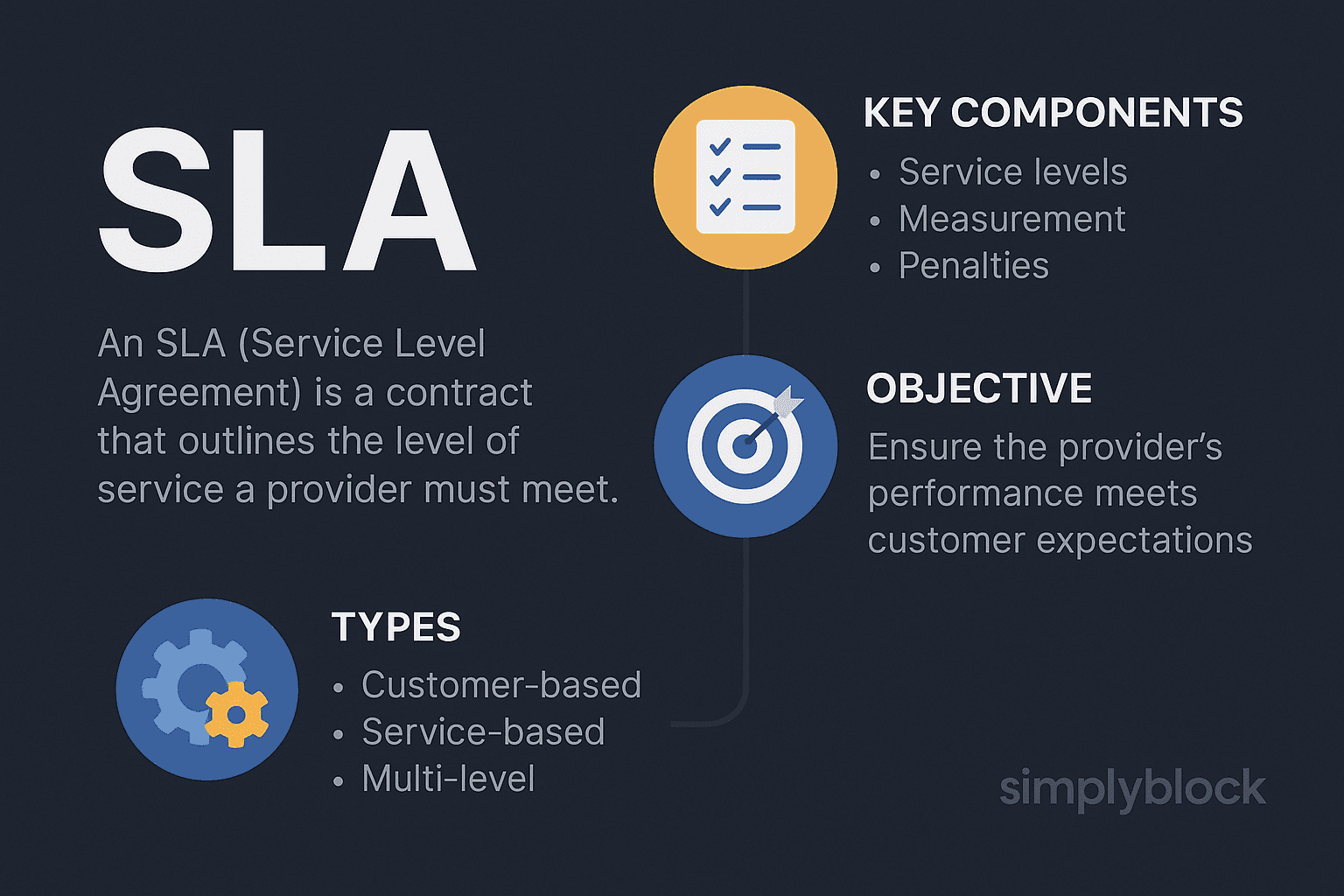SLA
Terms related to simplyblock
A Service Level Agreement (SLA) is a formal, legally binding contract between a service provider and a customer that defines the expected level of service. SLAs are foundational to both internal IT service operations and third-party vendor relationships. They outline key metrics such as uptime guarantees, response times, performance thresholds, and remedies in case of non-compliance.
In cloud computing, storage infrastructure, and Kubernetes-based platforms, SLAs are crucial for aligning business-critical applications with operational performance guarantees. Well-crafted SLAs support transparency, accountability, and business continuity across on-premises, hybrid, and multi-cloud deployments.
How SLAs Work
SLAs define quantifiable metrics that a provider must meet, commonly including:
- Uptime/Availability (e.g., 99.9% or 99.999%)
- Latency Thresholds
- Throughput Guarantees
- Incident Response Time
- Support Resolution Timeframes
- Data Durability
Each SLA may include penalties or credits if the provider fails to meet specified targets. For instance, if an SLA promises 99.99% uptime but the actual uptime is 99.5%, the customer might be entitled to service credits or other forms of compensation.
In platforms like simplyblock, SLA compliance is supported by fault-tolerant infrastructure, intelligent storage tiering, and real-time telemetry to ensure sustained IOPS, low latency, and volume-level resilience.

Benefits of SLAs
SLAs provide measurable value for both service providers and their customers:
- Clear Expectations: Prevents ambiguity around performance, availability, and support.
- Operational Alignment: Ensures service delivery meets business and application requirements.
- Risk Mitigation: Offers a mechanism for accountability and financial recourse in case of failure.
- Performance Monitoring: Enables tracking against specific metrics (e.g., IOPS, latency).
- Customer Trust: Strengthens confidence in infrastructure reliability and support responsiveness.
SLAs are especially relevant in storage environments supporting mission-critical workloads like databases in Kubernetes or hybrid multi-cloud storage.
Key SLA Metrics and What They Mean
Understanding SLA metrics helps set clear expectations between service providers and clients. These benchmarks ensure accountability, performance tracking, and continuous improvement.
| SLA Metric | Definition | Typical Range |
|---|---|---|
| Uptime | Percentage of time the service is operational | 99.9% – 99.999% |
| Latency | Maximum acceptable delay in processing or access | <1 ms – 20 ms |
| IOPS | Guaranteed input/output operations per second | Varies by tier |
| RTO (Recovery Time) | Time to restore service after failure | <5 mins – 4 hours |
| RPO (Recovery Point) | Maximum acceptable data loss time window | Seconds to hours |
| MTTR | Mean Time to Recovery | Minutes to hours |
Use Cases for SLAs
SLAs are essential in:
- Cloud Storage Services: Ensuring consistent data access for compute workloads.
- Disaster Recovery Planning: Formalizing RTO/RPO thresholds for backup and restore strategies.
- Database Hosting: Guaranteeing throughput and latency for performance-sensitive workloads.
- Kubernetes Clusters: Defining persistent volume uptime and failover behavior.
- Multi-Tenant Environments: Enforcing Quality of Service (QoS) in shared infrastructure.
SLA in Simplyblock™
At simplyblock, SLA compliance is embedded in every layer of the platform. This includes:
- Infrastructure-level redundancy via NVMe-over-TCP and erasure coding for fault tolerance.
- Telemetry-driven observability, tracking live metrics such as IOPS, throughput, and latency.
- QoS enforcement, ensuring that one workload’s behavior does not impact others in shared environments.
- Proactive scaling, made possible through a scale-out architecture that maintains SLA compliance as storage demand grows.
- Multi-cloud and edge support, where SLAs remain consistent across distributed deployments.
Customers benefit from predictable service levels whether they deploy simplyblock on Kubernetes, Proxmox VE, or in air-gapped edge environments.
Related Topics
SLAs intersect with many operational and architectural topics:
External Resources
- Service-Level Agreement – Wikipedia
- Overview of Service-Level Agreements – Microsoft Learn
- SLA Best Practices – AWS Well-Architected
- Google Cloud Platform Service Level Agreements
- Service Level Agreements (SLAs) – IBM Cloud Docs
Questions and Answers
An SLA (Service Level Agreement) defines the expected performance, availability, and support guarantees between a service provider and customer. In storage, SLAs often include uptime guarantees, IOPS targets, and recovery objectives that ensure trust and accountability in cloud-native infrastructure.
Typical SLA metrics include uptime (e.g., 99.99%), latency thresholds, data durability, and recovery time objectives (RTO). High-performance systems, such as NVMe over TCP platforms, often commit to sub-millisecond latency and high availability zones.
In Kubernetes, storage SLAs are tied to the reliability of CSI drivers and the underlying storage system. Kubernetes-native NVMe storage can help meet SLA requirements by delivering fast failover, dynamic provisioning, and consistent performance.
Yes. SLAs may include security guarantees such as encryption at rest and compliance with regulations like GDPR or HIPAA. These commitments are critical in multi-tenant and regulated environments.
SLA violations often trigger penalties such as service credits or contract reassessments. More importantly, they can indicate that your storage solution isn’t delivering the reliability or performance needed, prompting a shift to more robust, software-defined alternatives.
